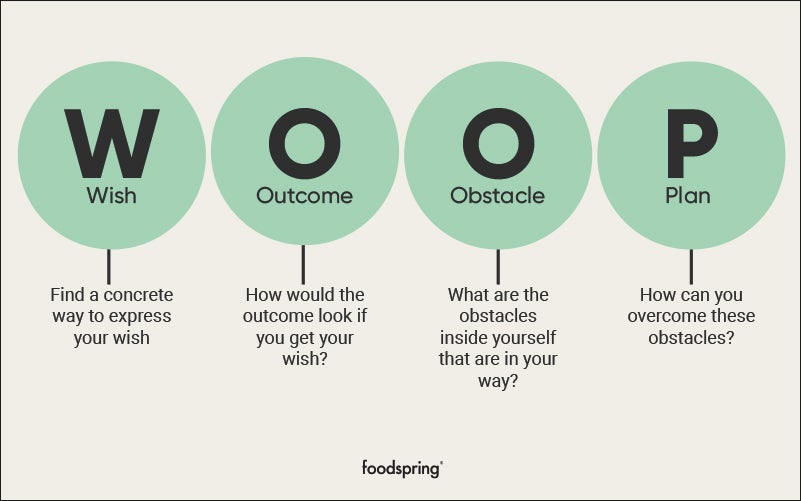How to Use the WOOP Method to Accomplish Your Goals
 ©FJ Jimenez
©FJ Jimenez
If you’re struggling to feel motivated, the WOOP method may be just what you need to reach your goals. Keep reading to find out more about this innovative strategy.
What is the WOOP method?
The WOOP method is a four-step, science-based, motivational strategy that may enable you to reach your goals. The steps include:
- Defining your goals
- Visualizing the end result
- Identifying possible obstacles
- Establishing solutions for possible obstacles, also known as “if […], then […]” plans
The WOOP method was developed by the renowned psychologist Gabriele Oettingen. During her 20 years of research in Hamburg and New York, she discovered that positive thinking alone is not enough to achieve one’s goals. She used her expert knowledge to develop a motivational method that would actually help people, and thus the WOOP method was born.[1]

The method combines two essential tools: mental contrasting and implementation intentions. By using them, you’re forced to think positively, visualize your goal (including the emotions related to it) and confront any obstacles, doubts, or fears that might get in the way of achieving it.
After using mental contrasting to juxtapose positive and negative thoughts, the next step is to use implementation intentions to come up with an “if […], then […]” plan. This means thinking carefully about what could happen (whether positive or negative), and what you’ll need to do to overcome it.
For many people, simply going through the process of goal setting is enough to motivate them to get started. However, having a plan ready is necessary to keep yourself on track when the going gets tough. Anticipating possible obstacles and having solutions at the ready will give you the strength to see through the tougher parts of your journey.
Last but certainly not least, the WOOP method is designed to help you determine whether or not your goals are realistic right away. That way, you don’t end up wasting time on something that wasn’t a fit for you in the first place.
Our tip: Maintaining motivation is beneficial in many aspects of life, especially when it comes to athletic goals. In this article, we’ve compiled plenty of inspiring tips to help you reach your fitness dreams.
What does WOOP stand for?

According to Gabriele Oettingen, WOOP is an acronym for the four foundational steps.
- Wish
- Outcome
- Obstacle
- Plan
Remembering these four keywords will make it easier for you to stay on track.
Achieving your goals through mental contrasting: How does the WOOP method work?
In order to achieve your goals with the WOOP method, it’s important to follow it exactly as prescribed. That means taking the time to thoughtfully evaluate each step and answer each question honestly. Above all, following the steps in the correct order is of the utmost importance, according to Gabriele Oettingen. Start small instead of using the method to tackle your smart goals right away. You’ll have an easier time becoming familiar with and implementing the strategy if you’re using it to accomplish simple tasks at first. For example, some people begin by using it to make minor changes, whether that’s working out for 10 minutes a day or eating less sugar.

Using the WOOP method
To begin using the WOOP method, set aside 15 minutes of your time, choose a comfortable location, turn off your phone, and grab a paper and a pen to begin goal setting. Write the four letters of WOOP one below the other, leaving enough room for you to write about your goals as much as your heart desires.
Define your wish.
Ask yourself what you wish for and answer as specifically as possible. Rather than a generic “I want a better work-life balance,” hone in on what exactly will make that a reality, like “I want to work 28 hours a week starting in January.” The more details you include, the better the outcome will be.

Visualize what it would be like to have your wish come true.
Imagine you’ve achieved your goal. Ask yourself how it feels to work for only 28 hours a week and what kind of impact it has on your life? Write down your feelings in detail.
For example, you could write something like, “When I wake up on Monday, I feel relaxed because I know I only have 4 more short days to work and then I can do XYZ as I please. The feeling of stress on Monday morning is replaced by a feeling of fullness and joy. I feel free and appreciated.”
Think about what (if any) obstacles might get in your way.
After you’ve done the work of developing positive thoughts, it’s time to begin mentally contrasting with the potential negatives. Planning for possible obstacles is an essential element of the WOOP method, and what has made it so successful for many.
Let’s use the example from before: There can be many obstacles on your way to reducing your workload, from your employer not approving of the reduced hours, to you feeling like you’ll be perceived as lazy for asking for it. Acknowledging these possibilities before they happen will have you better prepared in case they do.
Plan in detail how you will deal with these obstacles.
Step three can be quite a reality check, but the fourth step is designed to help you figure out what to do next. Maybe you’re realizing that your goal isn’t very realistic at all, and you’d be better off transitioning to something else that’s more within reach. If you’re not deterred, it’s time to start planning concretely how you’ll overcome the obstacles that might be headed your way.
For example, consider working on a presentation to demonstrate to your employer why you’ll be more productive with a 28-hour work week. Show how it could optimize costs and expenses in a way that benefits them as well. If you’re afraid of being perceived as lazy, ask yourself where that stems from. And keep going from there.
6 Advantages of Mental Contrasting
Unlike a lot of personal development strategies, the WOOP method is scientifically proven to be beneficial. [2]
Mental contrasting is a tool that’s relatively easy to incorporate into your life and can be used to achieve any kind of goal, whether short, medium, or long term. What’s so great about it is that it forces you to ask and answer questions in a way that will actually help you find solutions. And that goes for all types of questions, from the existential to the day-to-day.

The WOOP method forces you to be honest with yourself and have a holistic approach to your projects. Though it might make you feel disillusioned to think about the negatives right from the jump, you’ll find that you’ll feel less overwhelmed in the long run and be more likely to achieve your wishes as a result.
We believe that these are the greatest benefits of mental contrasting:
#1 With the WOOP method, you may discover what you actually want.
Thinking about your wishes concretely will help you find out if they’re really what you want.
When you visualize achieving your goals, ask yourself if it feels right to you or if you’re trying to fulfill an expectation from someone else. If it does end up being what you want, it will be that much easier to obtain it if you’ve thought about it in detail.
#2 The WOOP method gets to the heart of the problem.
Identifying and naming potential obstacles is essential to confronting them. When the time comes, you’ll already be emotionally and mentally prepared for any possible difficulties. Clearly knowing what obstacles you may encounter and whether or not they can be overcome is the best way to develop coping strategies.
#3 The WOOP method can help avoid unnecessary stress.
Once you’ve identified potential obstacles, you can determine exactly how you will overcome them. That way, you won’t be shocked or overwhelmed if it does come to pass. You’ll have a strategy to fall back on so you can overcome it with calmness and serenity.
#4 The WOOP method helps you see clearly.
Are your wishes realistic? Is the time frame you’re aiming for realistic? What do you need to do to achieve your dreams? Would it be better to let go of this wish or to postpone it because you can’t afford it right now?

Mental contrasting allows you to differentiate between the realistic and unrealistic and choose what will help you move forward in life with self-awareness.
#5 The WOOP method can help you discover your priorities
By identifying what’s important to you, you can also better prioritize. Now that you actually know what you want to achieve, you can evaluate all of your actions in an informed way. Ask yourself what’s helping you to achieve this goal and what isn’t.
With a goal in mind, it can often be easier to see the little things in your daily life differently. For example, it may be in your best interest to skip that glass of wine with dinner if your goal is to get better at night.
If you evaluate the glass of wine differently and can connect it to the positive feeling associated with achieving your goal, you change the emotional connection you associate with drinking. That way you see skipping alcohol as an autonomous decision for your own self-satisfaction, rather than a punishment.
#6 The WOOP method teaches you how to work on yourself
Taking the time to evaluate what you want and how to get it is all work. More precisely, it’s work that you’re doing for yourself.

The WOOP method pushes you to confront and ask yourself questions, answer honestly, and take stock of your actions and beliefs. Even if it feels uncomfortable at first, you’ll only be better for it.
Losing weight with the WOOP method
The WOOP method is a popular strategy for losing and maintaining weight in the long term. Unlike many other fitness and weight loss programs, WOOP is not about quick solutions. It’s about thinking critically and taking steps to make lasting changes.

Here’s how you can lose weight with the WOOP method
Remember: With WOOP, it’s important to be as specific, honest, and authentic as possible. And absolutely don’t skip any steps.
Wish
I would like to lose 5 kilos in less than 3 months.
Outcome
With 5 kilos less, I can wear clothes that no longer fit and save money on future purchases. I have a sense of satisfaction when I look in the mirror and feel better in my body from healthier eating habits. I have more energy to accomplish the other things I want to achieve.
Obstacle
There are two obstacles in particular that might get in my way. First, my daily office routine. Every afternoon there is cake. I enjoy it because it’s tasty, but it also gives me a boost from my afternoon slump and a brief distraction from work. If I stop participating, work may become less fun. People may think of me as an outsider and I might have to explain my behavior.
Even when working from home, temptations lurk around every corner. The fridge is only a few steps away. That’s why I find it hard to hold back. I’m more easily distracted at home and more easily tempted to snack.
The next problem is alcohol. Boozy Friday nights with friends always end with pizza. The next morning, I’m too hungover to want to work out.
Plan
If there’s cake at the office, then I’m in. I’ll drink coffee and socialize, but I won’t have any cake. To make the moment easier on myself, I’ll bring a protein-rich snack. If people ask questions, I’ll answer honestly and without shame. Since I also don’t want people to think that I’m not allowing myself to indulge, I’ll bring a protein-rich treat to share with my coworkers once a week.
If I’m craving a snack at home, then I’ll resort to healthier alternatives like nuts or fresh fruit. I’ll also eat at set times and keep track of when I have my snacks and meals. Working from home gives me the advantage of being able to use my own kitchen to prepare balanced meals myself.If I go out for drinks on Friday, then I’ll only drink non-alcoholic beverages and stay as long as it’s fun while still sober. If my friends order a pizza, that’s when I’ll head home.
WOOP Method: Our conclusion
- The WOOP method is scientifically proven to be beneficial for improving motivation.
- The WOOP method requires carefully examining your wishes, emotions, and desires.
- It encourages you to formulate wishes clearly, take consideration of your emotions as they relate to a certain goal, anticipate possible problems, and develop solution strategies.
- The WOOP method allows you to set priorities, change perspective, and make conscious decisions for yourself.
Sources for this article
We at foodspring use only high-quality sources, including peer-reviewed studies, to support the facts within our articles. Read our editorial policy to learn more about how we fact-check and keep our content accurate, reliable, and trustworthy.
- [1] Oettingen, Gabriele: Die Psychologie des Gelingens. 2015.
- [2] Gabriele Oettingen (2012): Future thought and behaviour change, European Review of Social Psychology, 23:1, 1-63. https://doi.org/10.1080/10463283.2011.643698





























